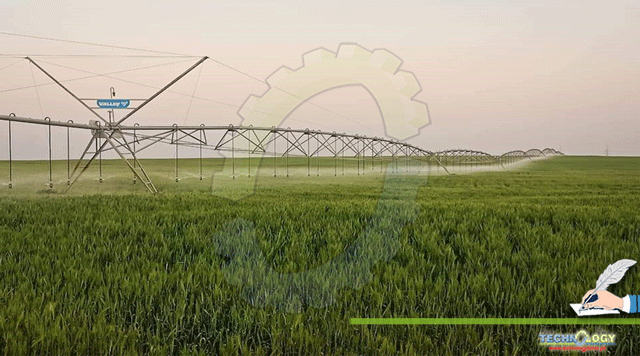Pakistan’s water resources are estimated to be approximately 144 MAF with annual renewable water resources of about 106 MAF. Being an agrarian economy, Pakistan’s economy relies heavily on agriculture.

By Muhammad Alamgeer and Hassan Munir
The sector provides 21% of the nation’s GDP and employs 45% of the labor force. About 97% of nations’ food requirements are fulfilled by domestic production. Out of the total cropped area in the country, about 58% is irrigation dependent. Hence, Pakistan’s overall agricultural output is highly dependent on water availability. About 97% of the freshwater in Pakistan is utilized by the agricultural sector which is in jeopardy due to the water shortage. Amid the water crisis, there is a need to switch to high-efficiency irrigation systems to ensure high agricultural productivity with minimal water loss.
A center-pivot irrigation system is an automated and pressurized water irrigation technique that applies water in a circular pattern, pivoting around the field’s center. Frank Zybach, a farmer from Nebraska, developed the first center-pivot irrigation system in 1948 after observing farmers drag ground irrigation pipes with sprinkler heads across farm fields. The “Zybach Self-Propelled Sprinkling Apparatus” was initially patented by Zybach in 1949. The pivot systems gained prominence rapidly. Center-pivot irrigation systems are advantageous due to their ability to maximize water usage and crop productivity. This method is particularly effective on larger lands.
The center pivot (CP) is a completely mechanical, permanently assembled, low-to-medium pressure automated irrigation system. The standard CP system consists of a single long irrigating pipeline connected to a central tower that rotates slowly in a circular pattern over the field and irrigates the plants with sprayers or sprinklers installed at regular intervals. Sprinkler nozzles are mounted along the pipeline or drooped from the lateral pipe through smaller pipes or cables.
The central tower with a pivot mechanism and electric main control panel is affixed to a tiny concrete structure at a fixed water supply (hydrant) in the middle of the field. The entire irrigation pipeline is lifted above the ground by “A” frame towers on wheels, lengthy spans, steel trusses, and cables, with a spray gun dangling from the end of the pipe. The entire system revolves slowly, at a usual speed (last span) of 2–3 meters per minute, around the fixed pivot, self-propelled, applying water as overhead spray irrigation and circling the region. Each wheeled tower is equipped with a small electric power unit as part of the propulsion system. A system of automatic alignment always maintains the irrigation pipeline’s alignment.
In a CP system, flow rates and gallons per minute (GPM) can be adjusted, and pressure regulators can be used to create a high-flow or low-flow system, depending on water use requirements. In the meantime, the farm management software enables farmers to monitor and record their irrigation data, including analytics such as irrigation frequency, expenses, and ROI results. The software also enables farmers to better monitor the sustainability of any kind of irrigation system and examine the economic trade-off between installing a center pivot or other irrigation systems.
Even though CP systems were originally powered by water, modern CP systems are driven by electricity sourced through a generator. They might also be powered by a hydraulic engine. The water supply is often provided by a well that draws water from an aquifer system. Although a 15% slope is advised, center pivots can be employed in fields with a 30% slope because they are terrain adaptable.
Center pivot systems are suitable for many agricultural locations because they can even be employed on sloping terrain. Additionally, this implies that farmers won’t need to level fields, transport dirt, or construct the levees and dikes required for flood irrigation systems.
Compared to several other surface irrigation techniques, center pivot irrigation requires less labor. There’s no need for channel digging in this method as was in traditional ones. Moreover, CP irrigation can minimize soil tillage and lower soil erosion and water runoff that can happen with ground irrigation. It is also noteworthy that less tillage promotes the decomposition of organic matter and crop residue into the soil. Furthermore, soil compaction is also minimized to a greater extent through this method.
CP systems are proven to be a wise investment for larger farm operations since they function automatically, require minimal labor once installed, and are typically long-lasting (more than 20 years) with only annual maintenance. A well-designed CP irrigation system can use 85 to 95% less water compared to sprinkler irrigation or flood irrigation systems when operating under optimal conditions. The simple adaptability of CP systems to chemigation or fertigation provides farmers with a uniform and affordable method for applying crop inputs like fertilizers or insecticides.